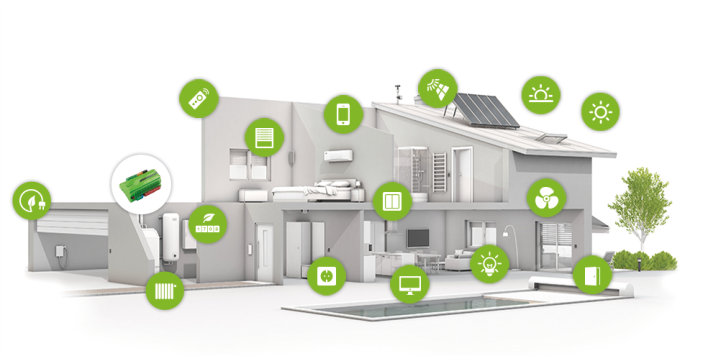Internet of Things and Intelligent Energy Efficiency
Preparing for an Era of Always-on, Internet-connected, IOT and Networked Devices
How Do We Save Energy in Our Homes? In Our Offices?
○ ○ ○ ○ ○ ○ ○ ○ ○ ○ ○ ○ ○ ○
University of California, Irvine
Energy Planning: CalPlug Workshop Series #9
Ubiquitous plug-load devices include appliances, electronics and tools—anything that plugs into an electrical outlet. Currently, these devices are responsible for as much as 20 percent of the electrical consumption in buildings, and 30 percent by 2030. To exacerbate the situation, a majority of these devices consume power even when not in use—the much dreaded “phantom power” which accounts for over 15 gigawatts of power consumption, worldwide, 24/7. The plug loads, if not well managed, could disable California’s plans for Zero Net Energy in new homes by 2020.
The California Plug Load Research Center (CalPlug) was established to improve energy efficiency in the use and design of appliances and consumer electronic devices. The Center has already earned research funding support from the California Energy Commission, for $1 million. CalPlug focuses on energy efficiency solutions, efficiency evaluations of consumer electronics, standards development, education and public outreach, and user behavior studies. CalPlug will address challenges in plug load efficiency for both residential and commercial buildings by collaborating closely with utilities, manufacturers, advocacy groups, research institutions, and energy policy makers.
May 12, 2016 / Agenda
Calit2 Building, UC Irvine
Welcome
- Professor G.P. Li, Director, Calit2 UC Irvine/California Plug Load Research Center
9:15 – 9:30 a.m.
- Opening Remarks, Brad Meister, California Energy Commission
ONGOING CALPLUG RESEARCH AND PROJECTS
9:30 – 10:15 a.m.
- CalPlug Project: Session 1
- Plug loads research roadmap and deep energy saving potential
10:30 – 11:15 a.m.
- CalPlug Project: Session 2
- Consumer-centric engagement for plug loads energy management
11:15 a.m. – Noon
- CalPlug Project: Session 3
- Smart energy efficiency with connected plug loads in zero net energy homes
RECENT TRENDS
1 – 2 p.m.
- IOT OPPORTUNITIES AND CHALLENGES AND INTELLIGENT ENERGY EFFICIENCY
- The big boom in the Internet of Things and its connectivity of billions of devices require energy to communicate with each other. As the front end of these connected devices are supposed to make our lives easier, simpler and more energy efficient, what about the back end of these connected devices and their energy requirements? Have we solved some of our energy problems, only to create new ones?
2 –3 p.m.
- ENERGY TODAY IS SMARTER, GREENER AND AUTOMATIC
- How are we pushing the boundaries to make our energy spaces smarter, cleaner and safer for consumers? What have we learned from yesterday to make us smarter today, and the environment better for tomorrow? Let’s explore our options and opportunities.
3:15 – 4:15 p.m.
- WHAT’S NEXT FOR CALIFORNIA?
- California has always been an undisputed leader in all things green. Like-minded energy efficiency champions are taking us to the next level via initiatives, policies and regulations. We have ideas but what are the next steps for us to continue to lead the way and stop climate change?
4:30 p.m.
- Networking Reception & CalPlug Demonstrations
Speakers:
- Teren Abear – SCE
- Matt Cohen – GBCI
- Paul Delaney – SCE
- Pierre Delforge - NRDC
- Richard Fleming – Richard Fleming Architect
- Sergio Gago – Calit2 (UCI)
- John Gillett – Energy Inspectors
- Jenna Jorns – The Climate Registry
- Michael Klopfer – CalPlug (UCI)
- Marco Levorato – UCI
- Alan Meier – LBL
- Joy Pixley – CalPlug (UCI)
- Shahid Sheikh– Intel
- Nalini Venkatasubramanian - UCI
- Linyi Xia – CalPlug (UCI)
- Building Standards
- California
- Citizen Science
- City-County Governments
- Climate Policy
- Energy
- Energy Policy
- Green Best Practices
- IOT
- LEED
- Planet Citizen
- Planet Citizens, Planet Scientists
- Renewable Energy
- Smart Homes
- Solar Energy
- Sustainability Policies
- Climate Change
- Colleges
- Earth360
- EarthPOV
- Earth Science
- Ecology Studies
- Environmental Full-cost Accounting
- Environmental Protection
- Environmental Security
- EOS eco Operating System
- Externalities
- Green Politics
- Internet
- Planet Scientist
- Planetary Science
- Policies
- Sea-Level Rise & Mitigation
- Sustainability
- Whole Earth
